Business Management
VerifiedAdded on 2023/01/23
|11
|2771
|55
AI Summary
This document discusses various aspects of business management, focusing on McDonald's Australia. It covers topics such as the history of McDonald's in Australia, the organizational purpose and structure, the role of managers, motivation and sustainable practices, and the differences between for-profit and non-profit CEOs.
Contribute Materials
Your contribution can guide someone’s learning journey. Share your
documents today.
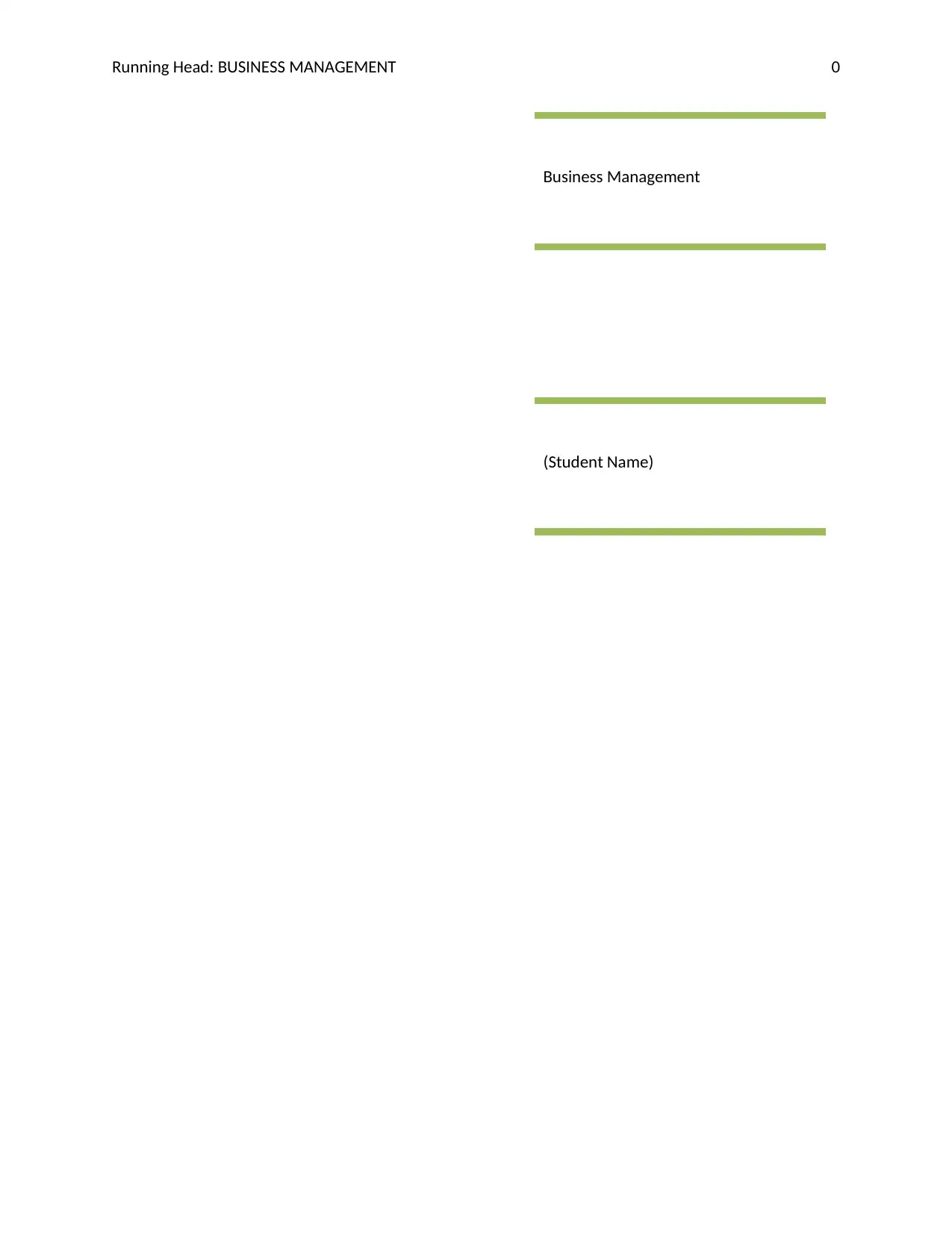
Running Head: BUSINESS MANAGEMENT 0
Business Management
(Student Name)
Business Management
(Student Name)
Secure Best Marks with AI Grader
Need help grading? Try our AI Grader for instant feedback on your assignments.
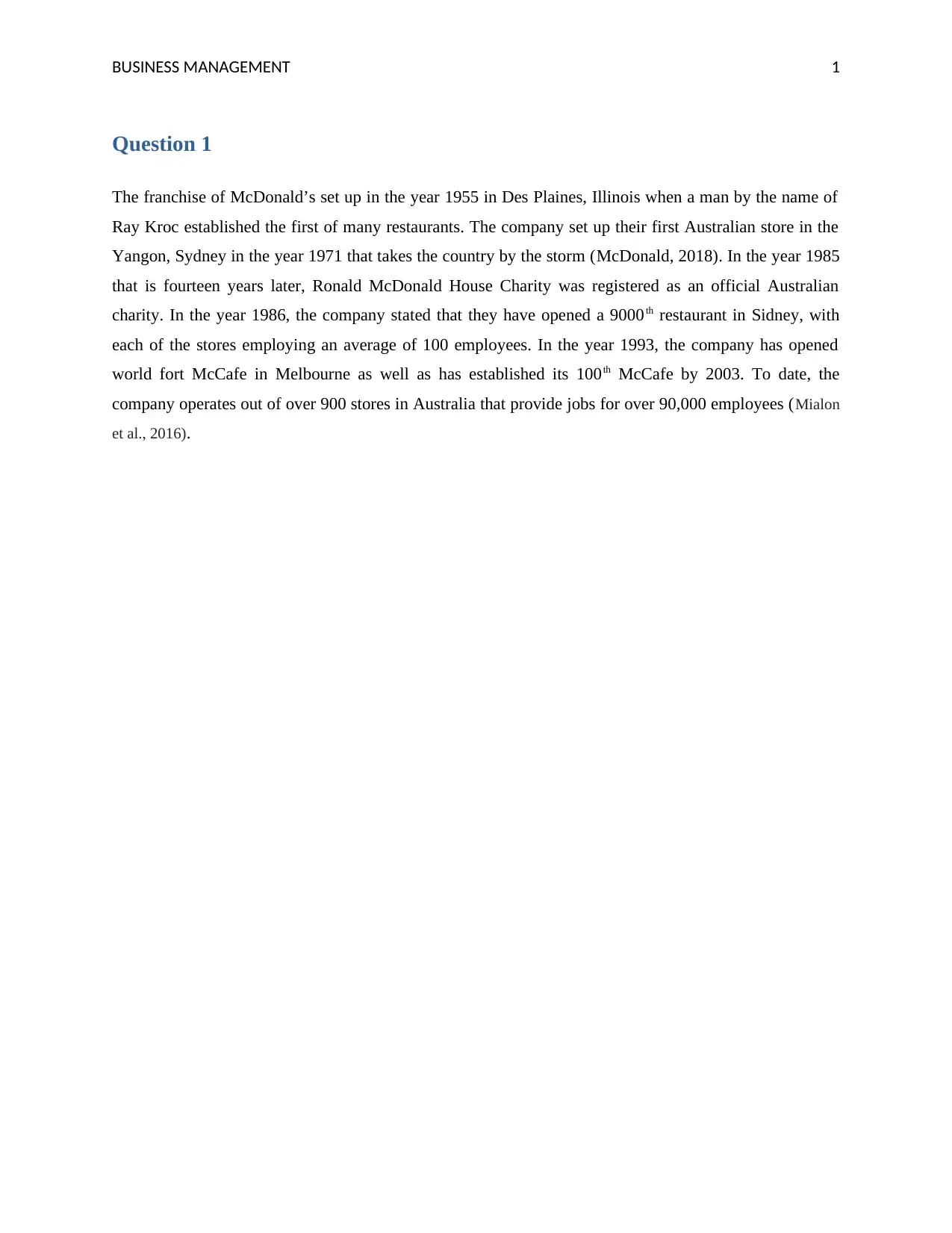
BUSINESS MANAGEMENT 1
Question 1
The franchise of McDonald’s set up in the year 1955 in Des Plaines, Illinois when a man by the name of
Ray Kroc established the first of many restaurants. The company set up their first Australian store in the
Yangon, Sydney in the year 1971 that takes the country by the storm (McDonald, 2018). In the year 1985
that is fourteen years later, Ronald McDonald House Charity was registered as an official Australian
charity. In the year 1986, the company stated that they have opened a 9000th restaurant in Sidney, with
each of the stores employing an average of 100 employees. In the year 1993, the company has opened
world fort McCafe in Melbourne as well as has established its 100th McCafe by 2003. To date, the
company operates out of over 900 stores in Australia that provide jobs for over 90,000 employees (Mialon
et al., 2016).
Question 1
The franchise of McDonald’s set up in the year 1955 in Des Plaines, Illinois when a man by the name of
Ray Kroc established the first of many restaurants. The company set up their first Australian store in the
Yangon, Sydney in the year 1971 that takes the country by the storm (McDonald, 2018). In the year 1985
that is fourteen years later, Ronald McDonald House Charity was registered as an official Australian
charity. In the year 1986, the company stated that they have opened a 9000th restaurant in Sidney, with
each of the stores employing an average of 100 employees. In the year 1993, the company has opened
world fort McCafe in Melbourne as well as has established its 100th McCafe by 2003. To date, the
company operates out of over 900 stores in Australia that provide jobs for over 90,000 employees (Mialon
et al., 2016).
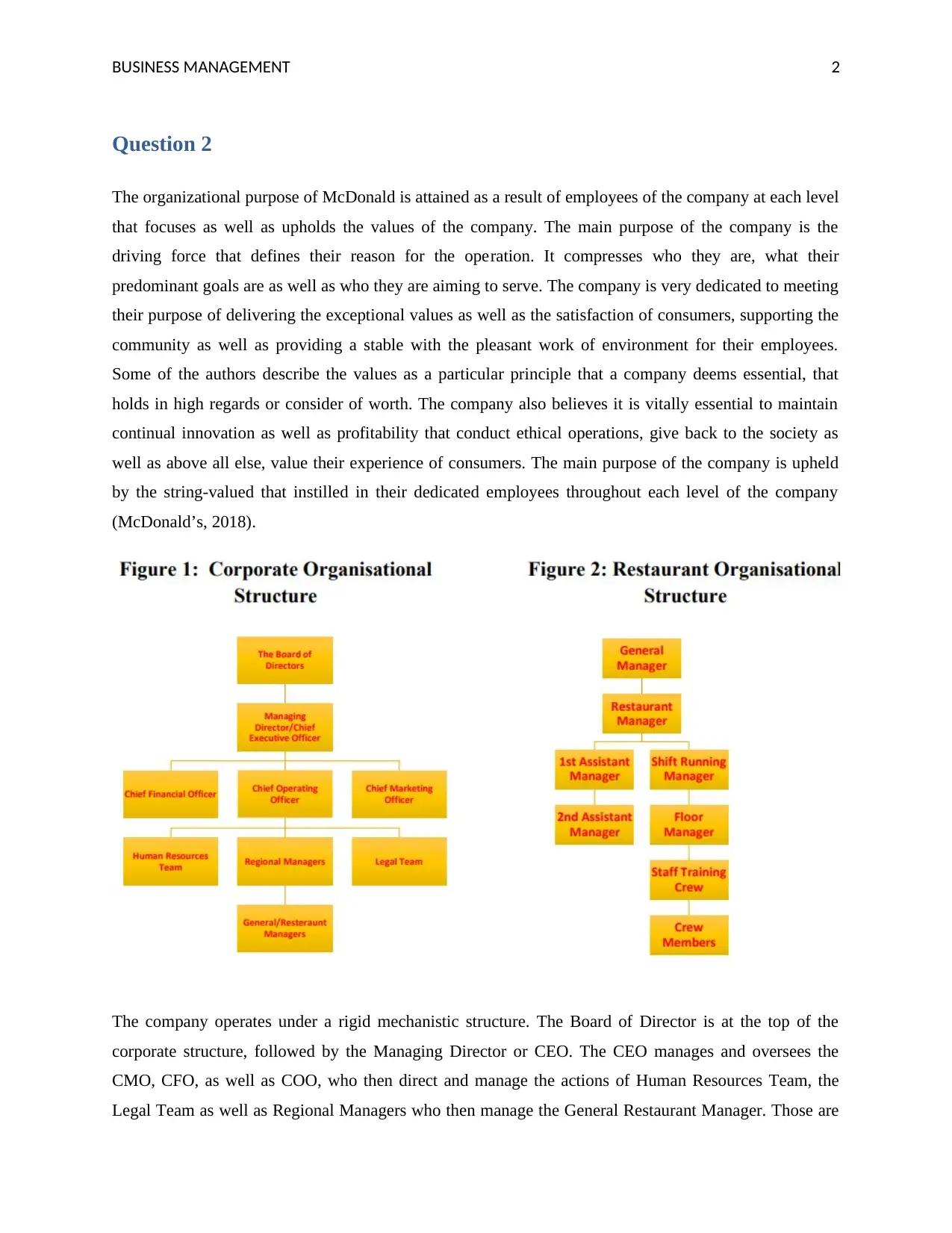
BUSINESS MANAGEMENT 2
Question 2
The organizational purpose of McDonald is attained as a result of employees of the company at each level
that focuses as well as upholds the values of the company. The main purpose of the company is the
driving force that defines their reason for the operation. It compresses who they are, what their
predominant goals are as well as who they are aiming to serve. The company is very dedicated to meeting
their purpose of delivering the exceptional values as well as the satisfaction of consumers, supporting the
community as well as providing a stable with the pleasant work of environment for their employees.
Some of the authors describe the values as a particular principle that a company deems essential, that
holds in high regards or consider of worth. The company also believes it is vitally essential to maintain
continual innovation as well as profitability that conduct ethical operations, give back to the society as
well as above all else, value their experience of consumers. The main purpose of the company is upheld
by the string-valued that instilled in their dedicated employees throughout each level of the company
(McDonald’s, 2018).
The company operates under a rigid mechanistic structure. The Board of Director is at the top of the
corporate structure, followed by the Managing Director or CEO. The CEO manages and oversees the
CMO, CFO, as well as COO, who then direct and manage the actions of Human Resources Team, the
Legal Team as well as Regional Managers who then manage the General Restaurant Manager. Those are
Question 2
The organizational purpose of McDonald is attained as a result of employees of the company at each level
that focuses as well as upholds the values of the company. The main purpose of the company is the
driving force that defines their reason for the operation. It compresses who they are, what their
predominant goals are as well as who they are aiming to serve. The company is very dedicated to meeting
their purpose of delivering the exceptional values as well as the satisfaction of consumers, supporting the
community as well as providing a stable with the pleasant work of environment for their employees.
Some of the authors describe the values as a particular principle that a company deems essential, that
holds in high regards or consider of worth. The company also believes it is vitally essential to maintain
continual innovation as well as profitability that conduct ethical operations, give back to the society as
well as above all else, value their experience of consumers. The main purpose of the company is upheld
by the string-valued that instilled in their dedicated employees throughout each level of the company
(McDonald’s, 2018).
The company operates under a rigid mechanistic structure. The Board of Director is at the top of the
corporate structure, followed by the Managing Director or CEO. The CEO manages and oversees the
CMO, CFO, as well as COO, who then direct and manage the actions of Human Resources Team, the
Legal Team as well as Regional Managers who then manage the General Restaurant Manager. Those are
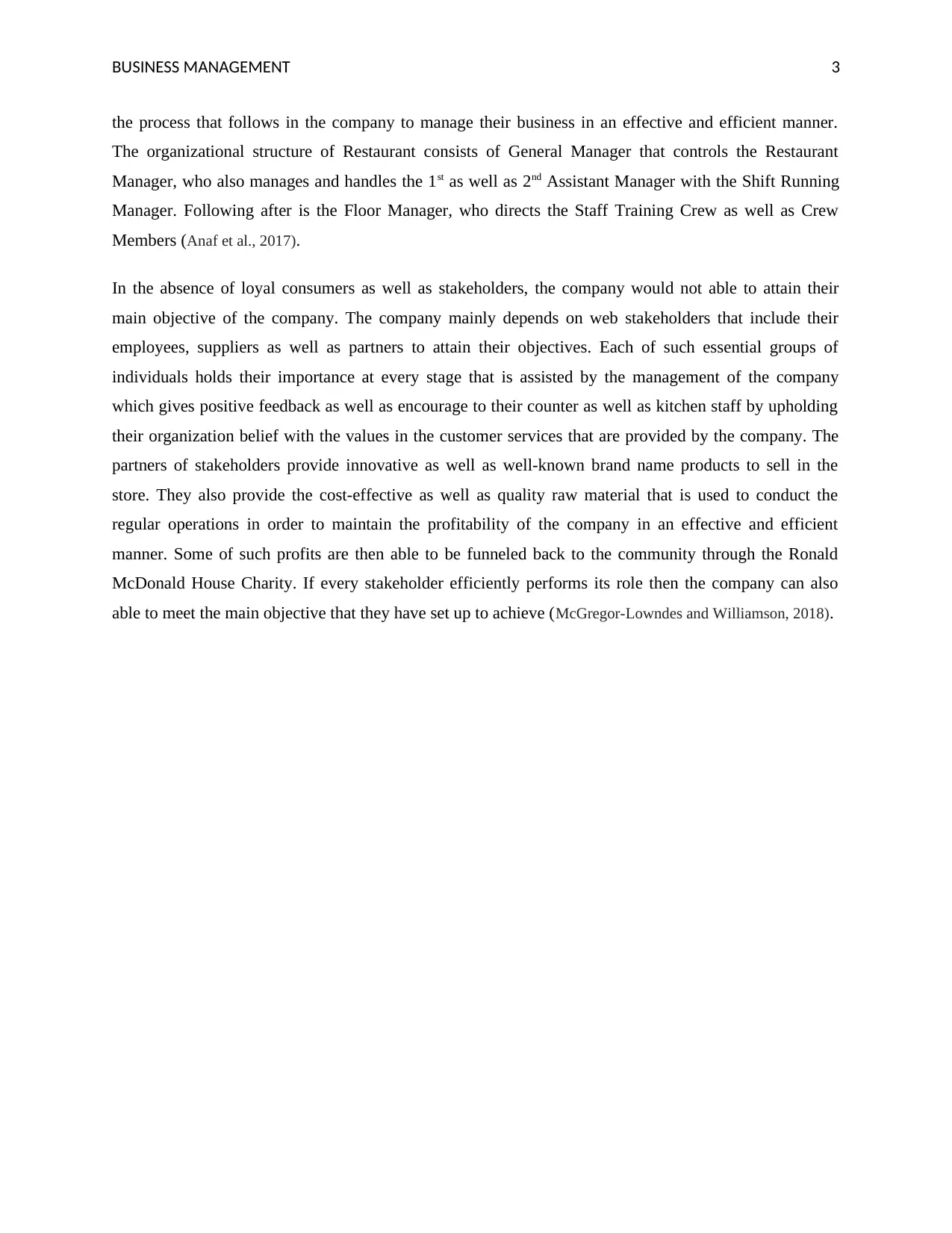
BUSINESS MANAGEMENT 3
the process that follows in the company to manage their business in an effective and efficient manner.
The organizational structure of Restaurant consists of General Manager that controls the Restaurant
Manager, who also manages and handles the 1st as well as 2nd Assistant Manager with the Shift Running
Manager. Following after is the Floor Manager, who directs the Staff Training Crew as well as Crew
Members (Anaf et al., 2017).
In the absence of loyal consumers as well as stakeholders, the company would not able to attain their
main objective of the company. The company mainly depends on web stakeholders that include their
employees, suppliers as well as partners to attain their objectives. Each of such essential groups of
individuals holds their importance at every stage that is assisted by the management of the company
which gives positive feedback as well as encourage to their counter as well as kitchen staff by upholding
their organization belief with the values in the customer services that are provided by the company. The
partners of stakeholders provide innovative as well as well-known brand name products to sell in the
store. They also provide the cost-effective as well as quality raw material that is used to conduct the
regular operations in order to maintain the profitability of the company in an effective and efficient
manner. Some of such profits are then able to be funneled back to the community through the Ronald
McDonald House Charity. If every stakeholder efficiently performs its role then the company can also
able to meet the main objective that they have set up to achieve (McGregor-Lowndes and Williamson, 2018).
the process that follows in the company to manage their business in an effective and efficient manner.
The organizational structure of Restaurant consists of General Manager that controls the Restaurant
Manager, who also manages and handles the 1st as well as 2nd Assistant Manager with the Shift Running
Manager. Following after is the Floor Manager, who directs the Staff Training Crew as well as Crew
Members (Anaf et al., 2017).
In the absence of loyal consumers as well as stakeholders, the company would not able to attain their
main objective of the company. The company mainly depends on web stakeholders that include their
employees, suppliers as well as partners to attain their objectives. Each of such essential groups of
individuals holds their importance at every stage that is assisted by the management of the company
which gives positive feedback as well as encourage to their counter as well as kitchen staff by upholding
their organization belief with the values in the customer services that are provided by the company. The
partners of stakeholders provide innovative as well as well-known brand name products to sell in the
store. They also provide the cost-effective as well as quality raw material that is used to conduct the
regular operations in order to maintain the profitability of the company in an effective and efficient
manner. Some of such profits are then able to be funneled back to the community through the Ronald
McDonald House Charity. If every stakeholder efficiently performs its role then the company can also
able to meet the main objective that they have set up to achieve (McGregor-Lowndes and Williamson, 2018).
Secure Best Marks with AI Grader
Need help grading? Try our AI Grader for instant feedback on your assignments.
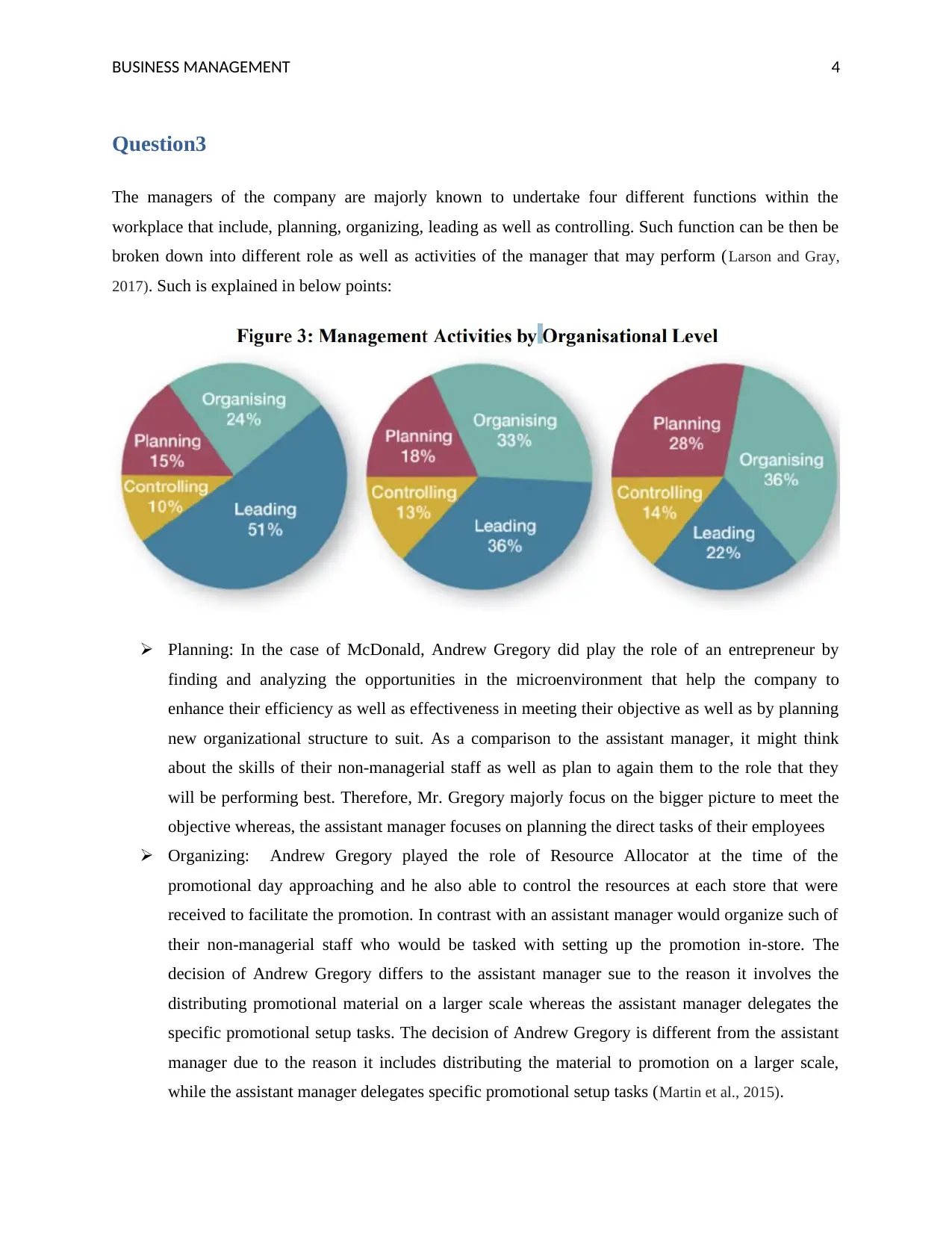
BUSINESS MANAGEMENT 4
Question3
The managers of the company are majorly known to undertake four different functions within the
workplace that include, planning, organizing, leading as well as controlling. Such function can be then be
broken down into different role as well as activities of the manager that may perform (Larson and Gray,
2017). Such is explained in below points:
Planning: In the case of McDonald, Andrew Gregory did play the role of an entrepreneur by
finding and analyzing the opportunities in the microenvironment that help the company to
enhance their efficiency as well as effectiveness in meeting their objective as well as by planning
new organizational structure to suit. As a comparison to the assistant manager, it might think
about the skills of their non-managerial staff as well as plan to again them to the role that they
will be performing best. Therefore, Mr. Gregory majorly focus on the bigger picture to meet the
objective whereas, the assistant manager focuses on planning the direct tasks of their employees
Organizing: Andrew Gregory played the role of Resource Allocator at the time of the
promotional day approaching and he also able to control the resources at each store that were
received to facilitate the promotion. In contrast with an assistant manager would organize such of
their non-managerial staff who would be tasked with setting up the promotion in-store. The
decision of Andrew Gregory differs to the assistant manager sue to the reason it involves the
distributing promotional material on a larger scale whereas the assistant manager delegates the
specific promotional setup tasks. The decision of Andrew Gregory is different from the assistant
manager due to the reason it includes distributing the material to promotion on a larger scale,
while the assistant manager delegates specific promotional setup tasks (Martin et al., 2015).
Question3
The managers of the company are majorly known to undertake four different functions within the
workplace that include, planning, organizing, leading as well as controlling. Such function can be then be
broken down into different role as well as activities of the manager that may perform (Larson and Gray,
2017). Such is explained in below points:
Planning: In the case of McDonald, Andrew Gregory did play the role of an entrepreneur by
finding and analyzing the opportunities in the microenvironment that help the company to
enhance their efficiency as well as effectiveness in meeting their objective as well as by planning
new organizational structure to suit. As a comparison to the assistant manager, it might think
about the skills of their non-managerial staff as well as plan to again them to the role that they
will be performing best. Therefore, Mr. Gregory majorly focus on the bigger picture to meet the
objective whereas, the assistant manager focuses on planning the direct tasks of their employees
Organizing: Andrew Gregory played the role of Resource Allocator at the time of the
promotional day approaching and he also able to control the resources at each store that were
received to facilitate the promotion. In contrast with an assistant manager would organize such of
their non-managerial staff who would be tasked with setting up the promotion in-store. The
decision of Andrew Gregory differs to the assistant manager sue to the reason it involves the
distributing promotional material on a larger scale whereas the assistant manager delegates the
specific promotional setup tasks. The decision of Andrew Gregory is different from the assistant
manager due to the reason it includes distributing the material to promotion on a larger scale,
while the assistant manager delegates specific promotional setup tasks (Martin et al., 2015).
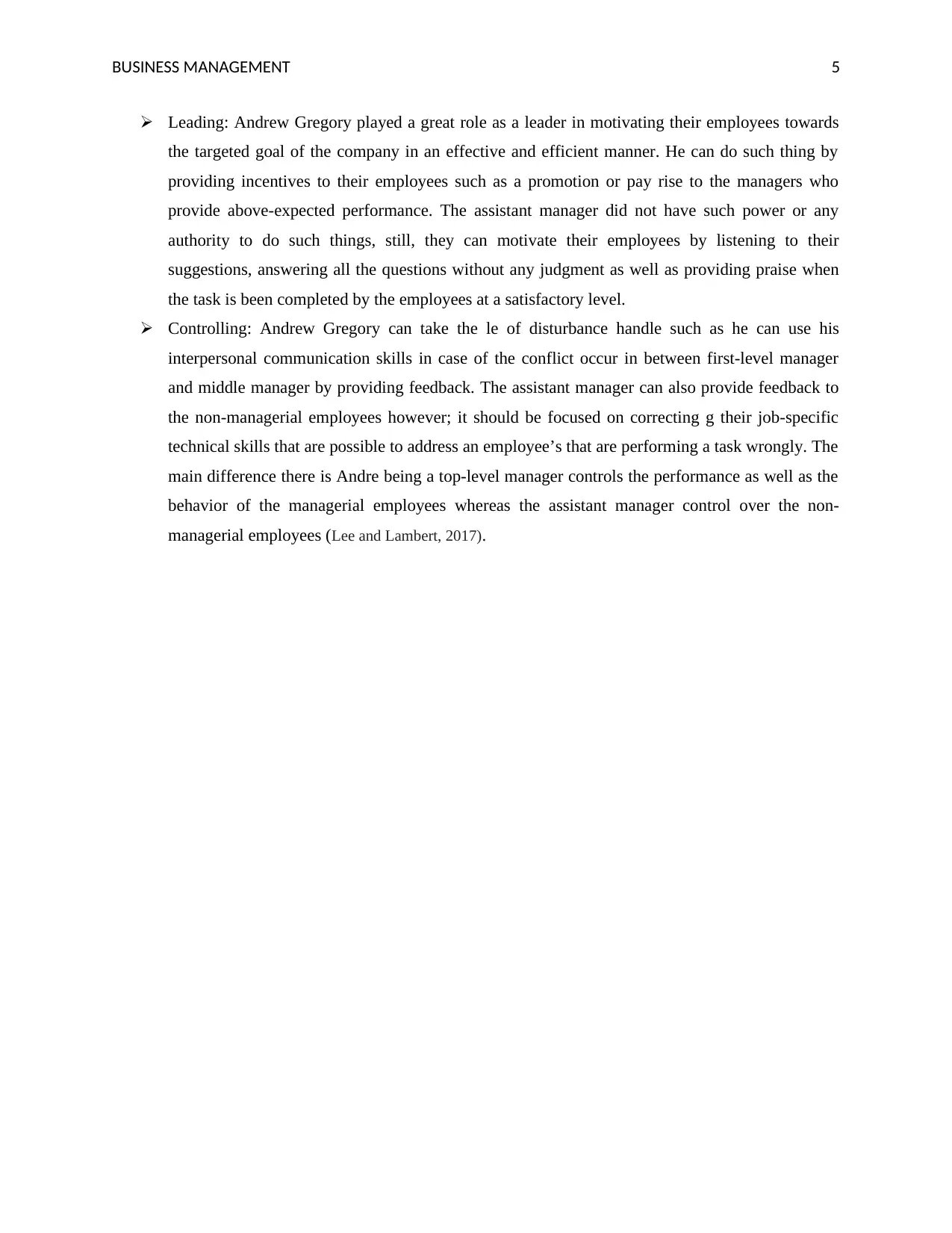
BUSINESS MANAGEMENT 5
Leading: Andrew Gregory played a great role as a leader in motivating their employees towards
the targeted goal of the company in an effective and efficient manner. He can do such thing by
providing incentives to their employees such as a promotion or pay rise to the managers who
provide above-expected performance. The assistant manager did not have such power or any
authority to do such things, still, they can motivate their employees by listening to their
suggestions, answering all the questions without any judgment as well as providing praise when
the task is been completed by the employees at a satisfactory level.
Controlling: Andrew Gregory can take the le of disturbance handle such as he can use his
interpersonal communication skills in case of the conflict occur in between first-level manager
and middle manager by providing feedback. The assistant manager can also provide feedback to
the non-managerial employees however; it should be focused on correcting g their job-specific
technical skills that are possible to address an employee’s that are performing a task wrongly. The
main difference there is Andre being a top-level manager controls the performance as well as the
behavior of the managerial employees whereas the assistant manager control over the non-
managerial employees (Lee and Lambert, 2017).
Leading: Andrew Gregory played a great role as a leader in motivating their employees towards
the targeted goal of the company in an effective and efficient manner. He can do such thing by
providing incentives to their employees such as a promotion or pay rise to the managers who
provide above-expected performance. The assistant manager did not have such power or any
authority to do such things, still, they can motivate their employees by listening to their
suggestions, answering all the questions without any judgment as well as providing praise when
the task is been completed by the employees at a satisfactory level.
Controlling: Andrew Gregory can take the le of disturbance handle such as he can use his
interpersonal communication skills in case of the conflict occur in between first-level manager
and middle manager by providing feedback. The assistant manager can also provide feedback to
the non-managerial employees however; it should be focused on correcting g their job-specific
technical skills that are possible to address an employee’s that are performing a task wrongly. The
main difference there is Andre being a top-level manager controls the performance as well as the
behavior of the managerial employees whereas the assistant manager control over the non-
managerial employees (Lee and Lambert, 2017).
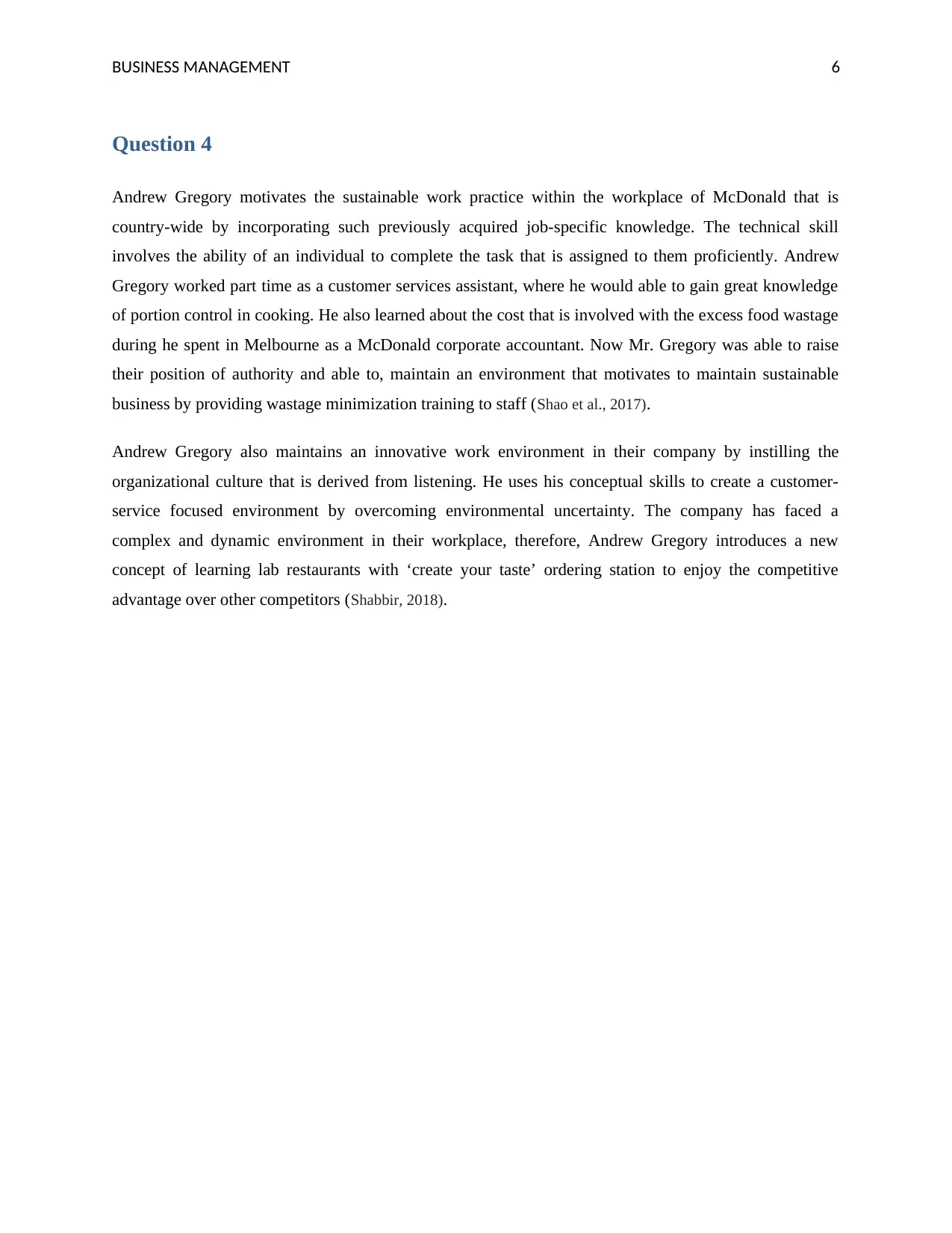
BUSINESS MANAGEMENT 6
Question 4
Andrew Gregory motivates the sustainable work practice within the workplace of McDonald that is
country-wide by incorporating such previously acquired job-specific knowledge. The technical skill
involves the ability of an individual to complete the task that is assigned to them proficiently. Andrew
Gregory worked part time as a customer services assistant, where he would able to gain great knowledge
of portion control in cooking. He also learned about the cost that is involved with the excess food wastage
during he spent in Melbourne as a McDonald corporate accountant. Now Mr. Gregory was able to raise
their position of authority and able to, maintain an environment that motivates to maintain sustainable
business by providing wastage minimization training to staff (Shao et al., 2017).
Andrew Gregory also maintains an innovative work environment in their company by instilling the
organizational culture that is derived from listening. He uses his conceptual skills to create a customer-
service focused environment by overcoming environmental uncertainty. The company has faced a
complex and dynamic environment in their workplace, therefore, Andrew Gregory introduces a new
concept of learning lab restaurants with ‘create your taste’ ordering station to enjoy the competitive
advantage over other competitors (Shabbir, 2018).
Question 4
Andrew Gregory motivates the sustainable work practice within the workplace of McDonald that is
country-wide by incorporating such previously acquired job-specific knowledge. The technical skill
involves the ability of an individual to complete the task that is assigned to them proficiently. Andrew
Gregory worked part time as a customer services assistant, where he would able to gain great knowledge
of portion control in cooking. He also learned about the cost that is involved with the excess food wastage
during he spent in Melbourne as a McDonald corporate accountant. Now Mr. Gregory was able to raise
their position of authority and able to, maintain an environment that motivates to maintain sustainable
business by providing wastage minimization training to staff (Shao et al., 2017).
Andrew Gregory also maintains an innovative work environment in their company by instilling the
organizational culture that is derived from listening. He uses his conceptual skills to create a customer-
service focused environment by overcoming environmental uncertainty. The company has faced a
complex and dynamic environment in their workplace, therefore, Andrew Gregory introduces a new
concept of learning lab restaurants with ‘create your taste’ ordering station to enjoy the competitive
advantage over other competitors (Shabbir, 2018).
Paraphrase This Document
Need a fresh take? Get an instant paraphrase of this document with our AI Paraphraser
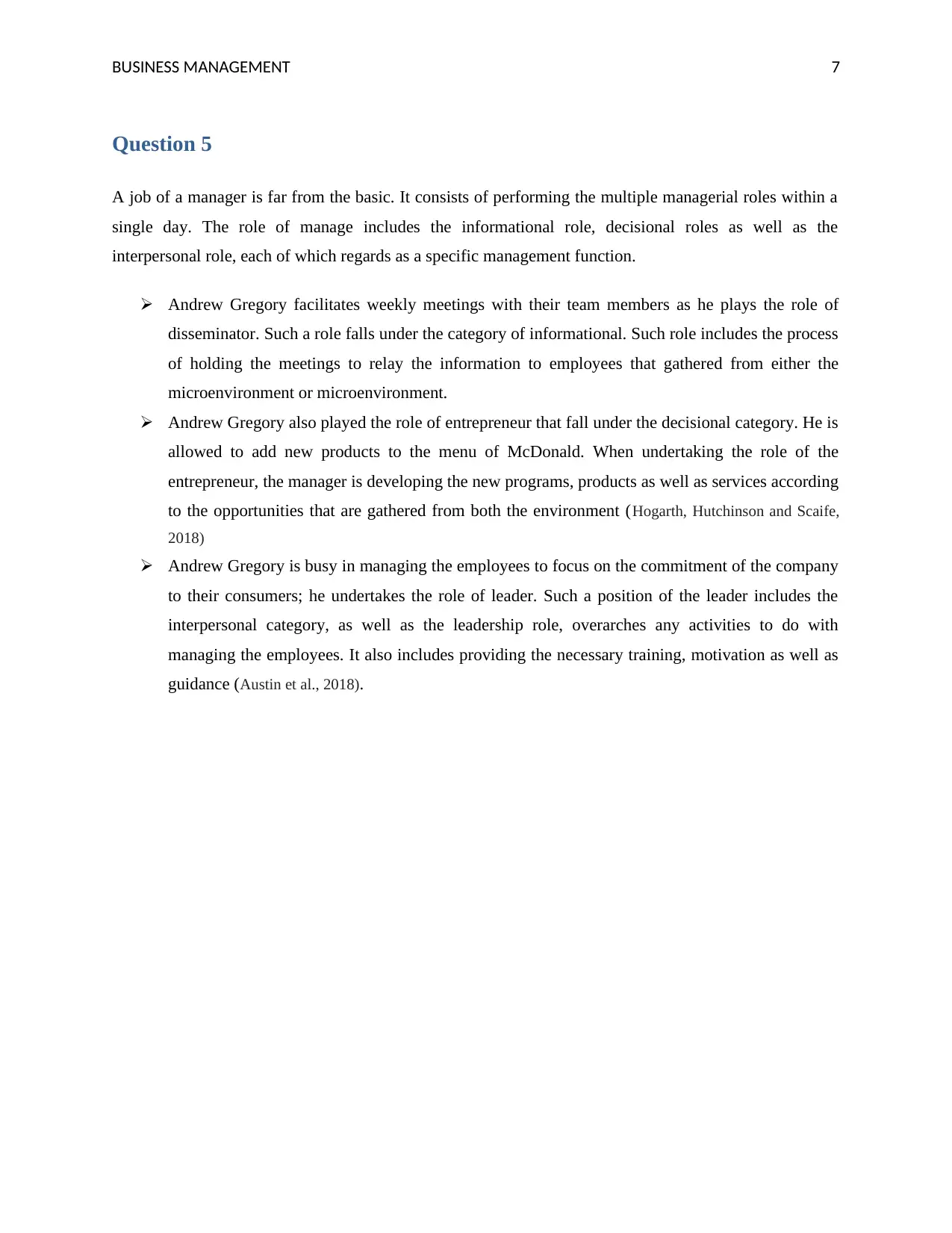
BUSINESS MANAGEMENT 7
Question 5
A job of a manager is far from the basic. It consists of performing the multiple managerial roles within a
single day. The role of manage includes the informational role, decisional roles as well as the
interpersonal role, each of which regards as a specific management function.
Andrew Gregory facilitates weekly meetings with their team members as he plays the role of
disseminator. Such a role falls under the category of informational. Such role includes the process
of holding the meetings to relay the information to employees that gathered from either the
microenvironment or microenvironment.
Andrew Gregory also played the role of entrepreneur that fall under the decisional category. He is
allowed to add new products to the menu of McDonald. When undertaking the role of the
entrepreneur, the manager is developing the new programs, products as well as services according
to the opportunities that are gathered from both the environment (Hogarth, Hutchinson and Scaife,
2018)
Andrew Gregory is busy in managing the employees to focus on the commitment of the company
to their consumers; he undertakes the role of leader. Such a position of the leader includes the
interpersonal category, as well as the leadership role, overarches any activities to do with
managing the employees. It also includes providing the necessary training, motivation as well as
guidance (Austin et al., 2018).
Question 5
A job of a manager is far from the basic. It consists of performing the multiple managerial roles within a
single day. The role of manage includes the informational role, decisional roles as well as the
interpersonal role, each of which regards as a specific management function.
Andrew Gregory facilitates weekly meetings with their team members as he plays the role of
disseminator. Such a role falls under the category of informational. Such role includes the process
of holding the meetings to relay the information to employees that gathered from either the
microenvironment or microenvironment.
Andrew Gregory also played the role of entrepreneur that fall under the decisional category. He is
allowed to add new products to the menu of McDonald. When undertaking the role of the
entrepreneur, the manager is developing the new programs, products as well as services according
to the opportunities that are gathered from both the environment (Hogarth, Hutchinson and Scaife,
2018)
Andrew Gregory is busy in managing the employees to focus on the commitment of the company
to their consumers; he undertakes the role of leader. Such a position of the leader includes the
interpersonal category, as well as the leadership role, overarches any activities to do with
managing the employees. It also includes providing the necessary training, motivation as well as
guidance (Austin et al., 2018).
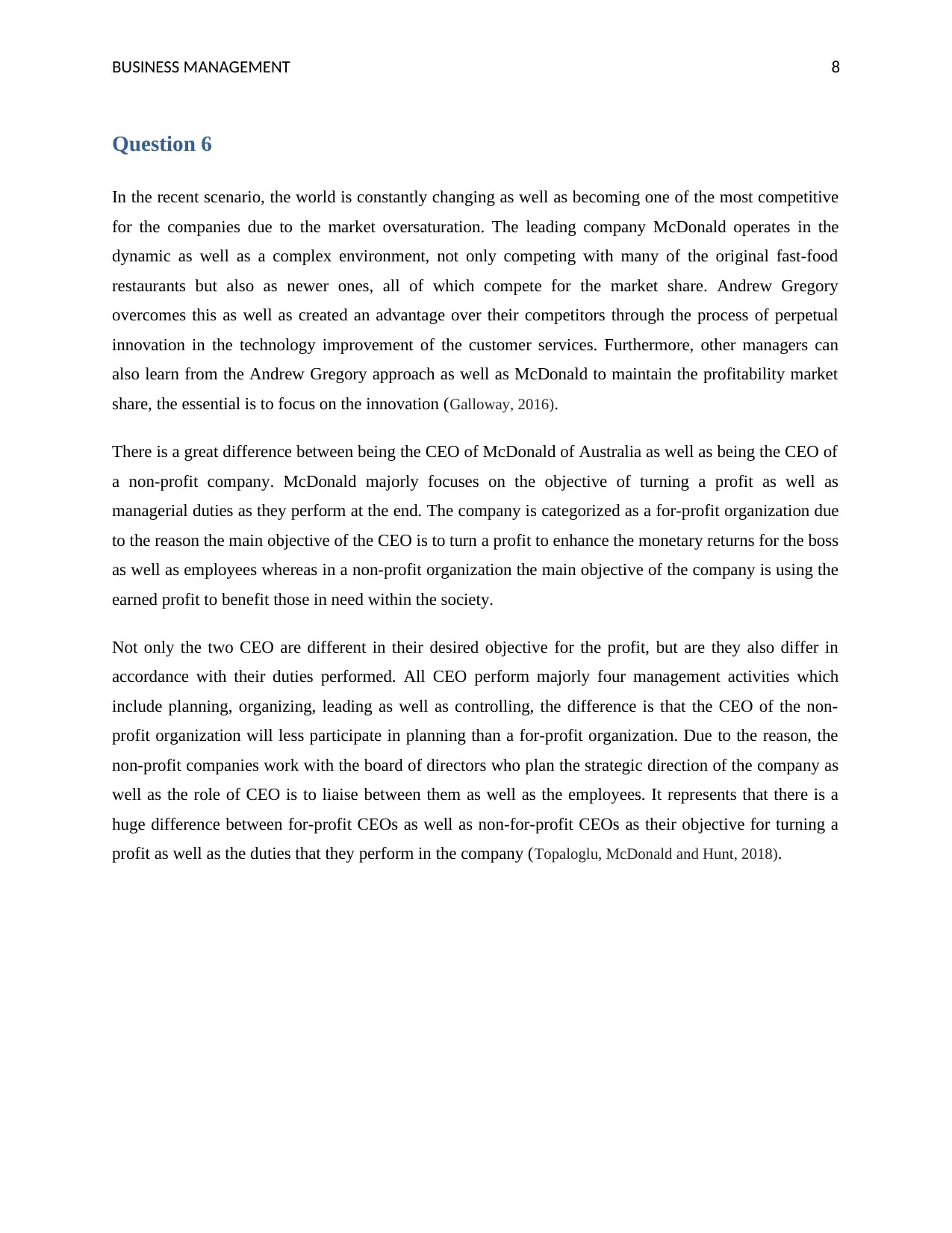
BUSINESS MANAGEMENT 8
Question 6
In the recent scenario, the world is constantly changing as well as becoming one of the most competitive
for the companies due to the market oversaturation. The leading company McDonald operates in the
dynamic as well as a complex environment, not only competing with many of the original fast-food
restaurants but also as newer ones, all of which compete for the market share. Andrew Gregory
overcomes this as well as created an advantage over their competitors through the process of perpetual
innovation in the technology improvement of the customer services. Furthermore, other managers can
also learn from the Andrew Gregory approach as well as McDonald to maintain the profitability market
share, the essential is to focus on the innovation (Galloway, 2016).
There is a great difference between being the CEO of McDonald of Australia as well as being the CEO of
a non-profit company. McDonald majorly focuses on the objective of turning a profit as well as
managerial duties as they perform at the end. The company is categorized as a for-profit organization due
to the reason the main objective of the CEO is to turn a profit to enhance the monetary returns for the boss
as well as employees whereas in a non-profit organization the main objective of the company is using the
earned profit to benefit those in need within the society.
Not only the two CEO are different in their desired objective for the profit, but are they also differ in
accordance with their duties performed. All CEO perform majorly four management activities which
include planning, organizing, leading as well as controlling, the difference is that the CEO of the non-
profit organization will less participate in planning than a for-profit organization. Due to the reason, the
non-profit companies work with the board of directors who plan the strategic direction of the company as
well as the role of CEO is to liaise between them as well as the employees. It represents that there is a
huge difference between for-profit CEOs as well as non-for-profit CEOs as their objective for turning a
profit as well as the duties that they perform in the company (Topaloglu, McDonald and Hunt, 2018).
Question 6
In the recent scenario, the world is constantly changing as well as becoming one of the most competitive
for the companies due to the market oversaturation. The leading company McDonald operates in the
dynamic as well as a complex environment, not only competing with many of the original fast-food
restaurants but also as newer ones, all of which compete for the market share. Andrew Gregory
overcomes this as well as created an advantage over their competitors through the process of perpetual
innovation in the technology improvement of the customer services. Furthermore, other managers can
also learn from the Andrew Gregory approach as well as McDonald to maintain the profitability market
share, the essential is to focus on the innovation (Galloway, 2016).
There is a great difference between being the CEO of McDonald of Australia as well as being the CEO of
a non-profit company. McDonald majorly focuses on the objective of turning a profit as well as
managerial duties as they perform at the end. The company is categorized as a for-profit organization due
to the reason the main objective of the CEO is to turn a profit to enhance the monetary returns for the boss
as well as employees whereas in a non-profit organization the main objective of the company is using the
earned profit to benefit those in need within the society.
Not only the two CEO are different in their desired objective for the profit, but are they also differ in
accordance with their duties performed. All CEO perform majorly four management activities which
include planning, organizing, leading as well as controlling, the difference is that the CEO of the non-
profit organization will less participate in planning than a for-profit organization. Due to the reason, the
non-profit companies work with the board of directors who plan the strategic direction of the company as
well as the role of CEO is to liaise between them as well as the employees. It represents that there is a
huge difference between for-profit CEOs as well as non-for-profit CEOs as their objective for turning a
profit as well as the duties that they perform in the company (Topaloglu, McDonald and Hunt, 2018).
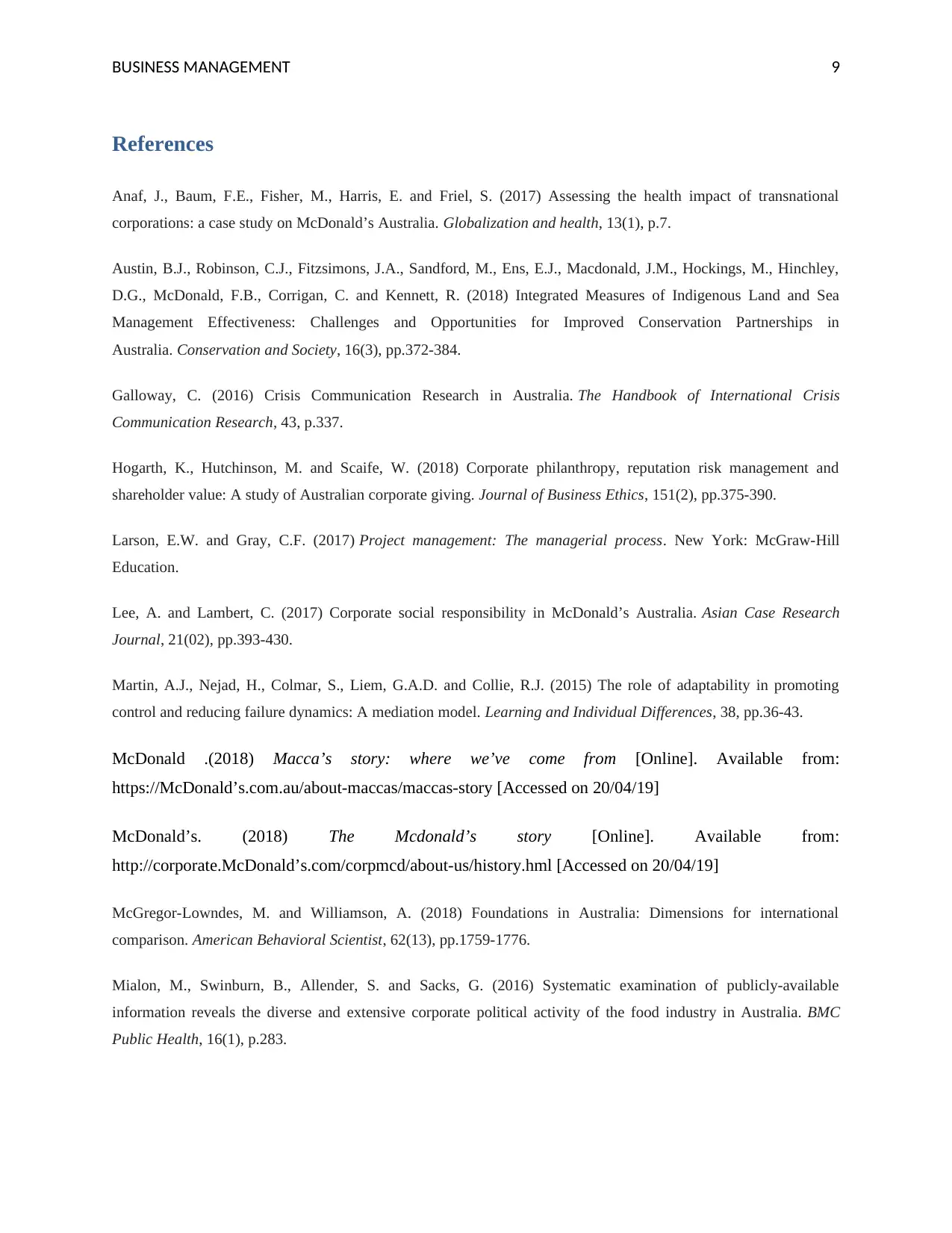
BUSINESS MANAGEMENT 9
References
Anaf, J., Baum, F.E., Fisher, M., Harris, E. and Friel, S. (2017) Assessing the health impact of transnational
corporations: a case study on McDonald’s Australia. Globalization and health, 13(1), p.7.
Austin, B.J., Robinson, C.J., Fitzsimons, J.A., Sandford, M., Ens, E.J., Macdonald, J.M., Hockings, M., Hinchley,
D.G., McDonald, F.B., Corrigan, C. and Kennett, R. (2018) Integrated Measures of Indigenous Land and Sea
Management Effectiveness: Challenges and Opportunities for Improved Conservation Partnerships in
Australia. Conservation and Society, 16(3), pp.372-384.
Galloway, C. (2016) Crisis Communication Research in Australia. The Handbook of International Crisis
Communication Research, 43, p.337.
Hogarth, K., Hutchinson, M. and Scaife, W. (2018) Corporate philanthropy, reputation risk management and
shareholder value: A study of Australian corporate giving. Journal of Business Ethics, 151(2), pp.375-390.
Larson, E.W. and Gray, C.F. (2017) Project management: The managerial process. New York: McGraw-Hill
Education.
Lee, A. and Lambert, C. (2017) Corporate social responsibility in McDonald’s Australia. Asian Case Research
Journal, 21(02), pp.393-430.
Martin, A.J., Nejad, H., Colmar, S., Liem, G.A.D. and Collie, R.J. (2015) The role of adaptability in promoting
control and reducing failure dynamics: A mediation model. Learning and Individual Differences, 38, pp.36-43.
McDonald .(2018) Macca’s story: where we’ve come from [Online]. Available from:
https://McDonald’s.com.au/about-maccas/maccas-story [Accessed on 20/04/19]
McDonald’s. (2018) The Mcdonald’s story [Online]. Available from:
http://corporate.McDonald’s.com/corpmcd/about-us/history.hml [Accessed on 20/04/19]
McGregor-Lowndes, M. and Williamson, A. (2018) Foundations in Australia: Dimensions for international
comparison. American Behavioral Scientist, 62(13), pp.1759-1776.
Mialon, M., Swinburn, B., Allender, S. and Sacks, G. (2016) Systematic examination of publicly-available
information reveals the diverse and extensive corporate political activity of the food industry in Australia. BMC
Public Health, 16(1), p.283.
References
Anaf, J., Baum, F.E., Fisher, M., Harris, E. and Friel, S. (2017) Assessing the health impact of transnational
corporations: a case study on McDonald’s Australia. Globalization and health, 13(1), p.7.
Austin, B.J., Robinson, C.J., Fitzsimons, J.A., Sandford, M., Ens, E.J., Macdonald, J.M., Hockings, M., Hinchley,
D.G., McDonald, F.B., Corrigan, C. and Kennett, R. (2018) Integrated Measures of Indigenous Land and Sea
Management Effectiveness: Challenges and Opportunities for Improved Conservation Partnerships in
Australia. Conservation and Society, 16(3), pp.372-384.
Galloway, C. (2016) Crisis Communication Research in Australia. The Handbook of International Crisis
Communication Research, 43, p.337.
Hogarth, K., Hutchinson, M. and Scaife, W. (2018) Corporate philanthropy, reputation risk management and
shareholder value: A study of Australian corporate giving. Journal of Business Ethics, 151(2), pp.375-390.
Larson, E.W. and Gray, C.F. (2017) Project management: The managerial process. New York: McGraw-Hill
Education.
Lee, A. and Lambert, C. (2017) Corporate social responsibility in McDonald’s Australia. Asian Case Research
Journal, 21(02), pp.393-430.
Martin, A.J., Nejad, H., Colmar, S., Liem, G.A.D. and Collie, R.J. (2015) The role of adaptability in promoting
control and reducing failure dynamics: A mediation model. Learning and Individual Differences, 38, pp.36-43.
McDonald .(2018) Macca’s story: where we’ve come from [Online]. Available from:
https://McDonald’s.com.au/about-maccas/maccas-story [Accessed on 20/04/19]
McDonald’s. (2018) The Mcdonald’s story [Online]. Available from:
http://corporate.McDonald’s.com/corpmcd/about-us/history.hml [Accessed on 20/04/19]
McGregor-Lowndes, M. and Williamson, A. (2018) Foundations in Australia: Dimensions for international
comparison. American Behavioral Scientist, 62(13), pp.1759-1776.
Mialon, M., Swinburn, B., Allender, S. and Sacks, G. (2016) Systematic examination of publicly-available
information reveals the diverse and extensive corporate political activity of the food industry in Australia. BMC
Public Health, 16(1), p.283.
Secure Best Marks with AI Grader
Need help grading? Try our AI Grader for instant feedback on your assignments.
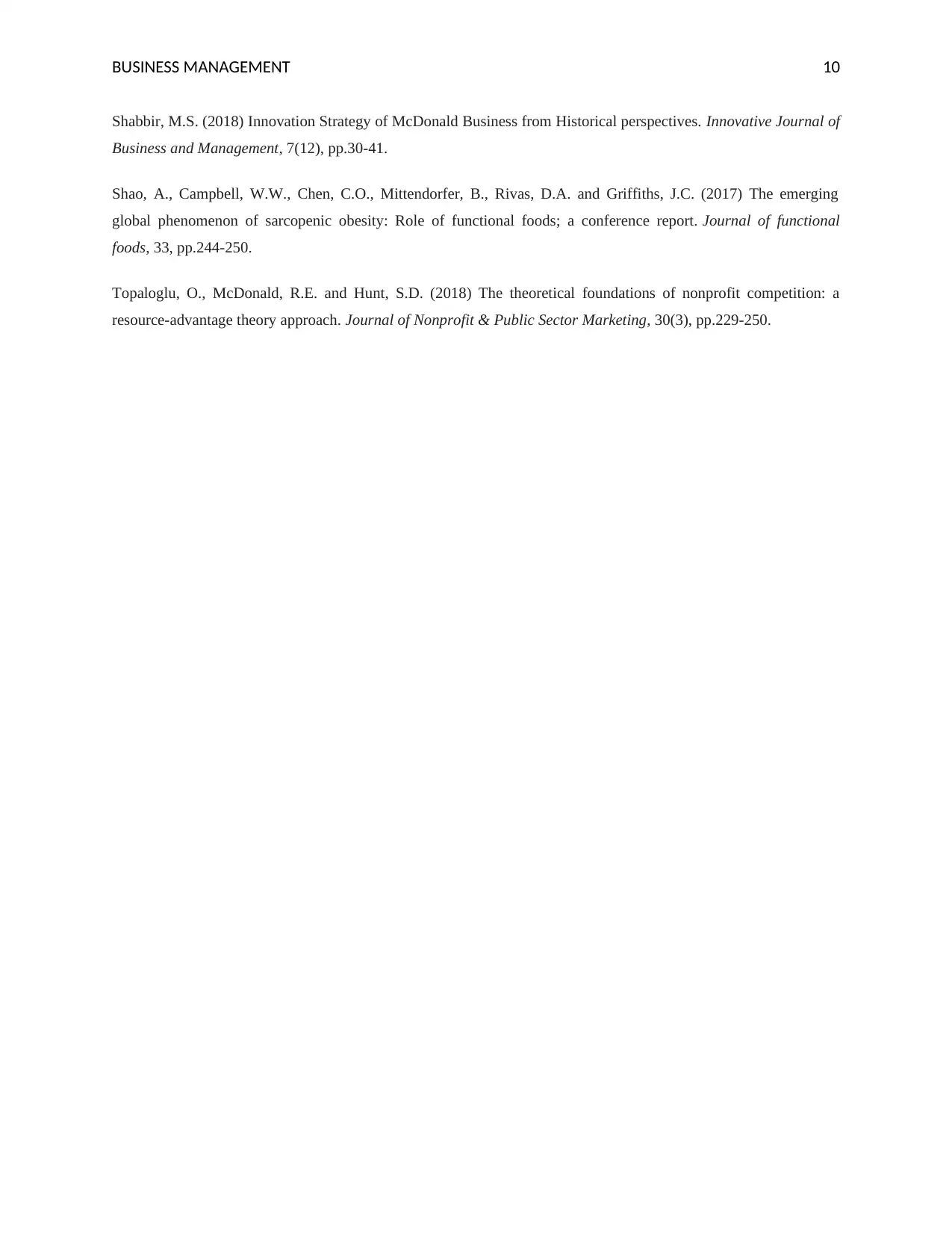
BUSINESS MANAGEMENT 10
Shabbir, M.S. (2018) Innovation Strategy of McDonald Business from Historical perspectives. Innovative Journal of
Business and Management, 7(12), pp.30-41.
Shao, A., Campbell, W.W., Chen, C.O., Mittendorfer, B., Rivas, D.A. and Griffiths, J.C. (2017) The emerging
global phenomenon of sarcopenic obesity: Role of functional foods; a conference report. Journal of functional
foods, 33, pp.244-250.
Topaloglu, O., McDonald, R.E. and Hunt, S.D. (2018) The theoretical foundations of nonprofit competition: a
resource-advantage theory approach. Journal of Nonprofit & Public Sector Marketing, 30(3), pp.229-250.
Shabbir, M.S. (2018) Innovation Strategy of McDonald Business from Historical perspectives. Innovative Journal of
Business and Management, 7(12), pp.30-41.
Shao, A., Campbell, W.W., Chen, C.O., Mittendorfer, B., Rivas, D.A. and Griffiths, J.C. (2017) The emerging
global phenomenon of sarcopenic obesity: Role of functional foods; a conference report. Journal of functional
foods, 33, pp.244-250.
Topaloglu, O., McDonald, R.E. and Hunt, S.D. (2018) The theoretical foundations of nonprofit competition: a
resource-advantage theory approach. Journal of Nonprofit & Public Sector Marketing, 30(3), pp.229-250.
1 out of 11
Related Documents
Your All-in-One AI-Powered Toolkit for Academic Success.
+13062052269
info@desklib.com
Available 24*7 on WhatsApp / Email
![[object Object]](/_next/static/media/star-bottom.7253800d.svg)
Unlock your academic potential
© 2024 | Zucol Services PVT LTD | All rights reserved.





